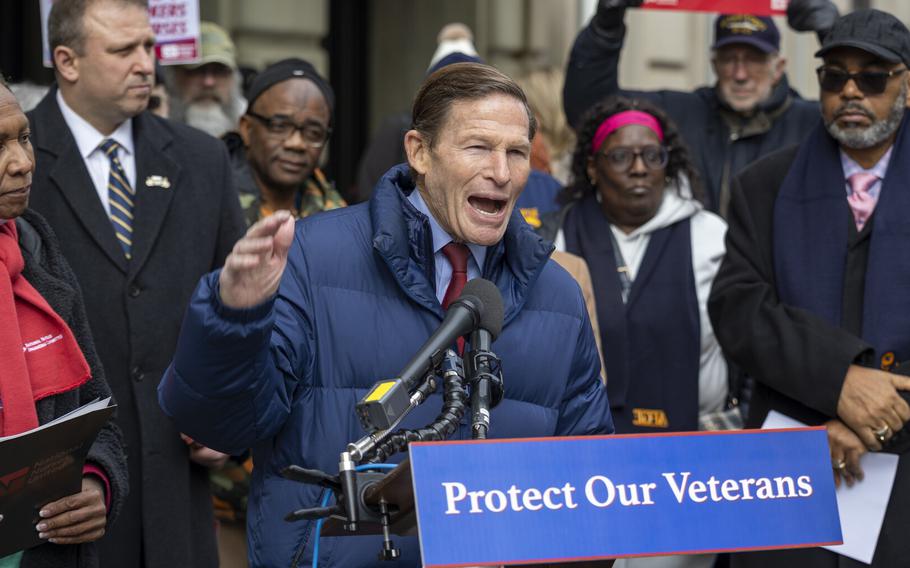
Marine Corps veteran Andrew Lennox, seen here during a deployment to the Middle East, was terminated from his administrative post at the Ann Arbor VA Healthcare System in Michigan when the Department of Veterans Affairs fired more than 1,000 probationary workers who had been in their positions for less than a year. (Andrew Lennox)
WASHINGTON — Marine Corps veteran Andrew Lennox was wrapping up his last day of online orientation as a newly hired administrative officer at Ann Arbor VA Healthcare System in Michigan, when his cell phone pinged alerting him to incoming email.
As a supervisor in primary care services at the medical center run by the Department of Veterans Affairs, the 35-year-old former staff sergeant certified staff hours, handled equipment purchases and reviewed performance evaluations.
“I’ve loved my new job at the VA, and I have nothing but positive feedback,” Lennox said.
But when he scanned his messages Feb. 13, he saw a work email from Tracey Therit, the VA’s chief human capital officer. The message contained a formal letter stating his employment was no longer needed based on job performance. Lennox was fired, effectively immediately, after less than two months on the job.
He was among more than 1,000 workers across the VA new to their jobs who received similar notices of termination based on performance. The mass firings were part of a larger federal workforce reduction announced by President Donald Trump’s administration to downsize the government.
But the layoffs are impacting many veterans, who represent approximately one-third of all federal workers, according to figures from the Office of Personnel Management. Richard Blumenthal, D-Conn., who is a member of the Senate Veterans’ Affairs Committee, blasted the Trump administration for “attempting to balance the budget on the backs of veterans.”

Sen. Richard Blumenthal, D-Conn., speaks during a rally outside the Department of Veterans Affairs headquarters in Washington on Feb. 13, 2025. (Eric Kayne/Stars and Stripes)
“Let’s call this what it is — it is a middle finger to our heroes and their lives of service,” Sen. Tammy Duckworth, D-Ill., a member of the Senate Veterans’ Affairs and Armed Services committees, said Wednesday at a news conference that she and Blumenthal called to discuss the impact of federal job reductions on veterans.
Duckworth, a retired Army National Guard lieutenant colonel, said she has heard from veterans across the country who are reaching out to her office or the Senate Veterans’ Affairs Committee to share their stories and concerns, especially about the cuts at the VA. She described the workforce reduction as a “probationary purge.”
At the end of fiscal 2023, 30% of federal employees were veterans compared to 5% of the total employed U.S. civilian labor force, according to the nonprofit Partnership for Public Service. About 25% of new federal hires in fiscal 2023 were veterans.
“I had been prepared for my job to be potentially impacted, but I was upset and angry when I got the termination notice. I had received so much positive feedback, but the letter stated it was from job performance and the burden was on me,” said Chelsea Milburn, who was fired after three months as a public affairs specialist at the Education Department. Milburn served in the Navy from 2014-19 and has continued her service in the Navy Reserve. She is now under review for a medical discharge from the Reserve based on a neurological condition.
In addition to job terminations at the VA and Education Department, hundreds of newly hired workers were fired last week from the Department of Health and Human Services, National Park Service and the Cybersecurity and Infrastructure Security Agency, among other agencies. Many were veterans.
“I understand that because I am the new guy, I would be the first to go,” said Lennox, who served for a decade in the Marines before ending active service in 2023. “But I object to the way my termination was carried out and the insincerity of it all. There was no feedback from anyone about negative job performance.”
The White House has not provided a final tally on how many employees have lost their jobs so far in the federal workforce reduction. Most of the federal workers terminated last week were on probation, meaning they had less than a year or two in their roles.
“As someone who has served in the military for 11 years — and having sacrificed a lot with my family — I missed a lot. Having this job ripped out from me and my family is unacceptable,” Milburn said.

Chelsea Milburn, a former Navy chief petty officer seen here aboard the USS Rushmore during a deployment in 2015, was fired last week after three months on the job as part of a larger federal workforce reduction across several agencies. (Chelsea Milburn)
At a Senate Veterans’ Affairs Committee hearing Wednesday to consider the nomination of Paul Lawrence as VA deputy secretary, Blumenthal expressed frustration about a lack of transparency from VA leaders about job reductions at the agency.
This committee “learns of far-reaching decisions after the fact,” Blumenthal said. “In the name of eliminating waste, Donald Trump and [tech billionaire] Elon Musk are laying waste to [the Department of] Veterans Affairs.”
He said about 30% of VA terminations are veterans.
“The younger probationary workers reflect the future of VA,” Blumenthal said. “We are going to demand action and accountability.”
Blumenthal and Duckworth said their offices are working with fired individuals to help them get their jobs back.
Probation for new federal workers represents a trial period, according to the OPM. Probationary workers lack full civil service protections as personnel with more tenure. They have limited rights for appeal. Probationary periods also apply to workers in new roles after promotions.
The formal notice of job termination received by Lennox stated the VA “finds based on your performance that you have not demonstrated that your further employment at the agency would be in the public interest. For this reason, the agency informs you that the agency is removing you from position with the agency and the federal civil service.”
Lennox, whose wife also works for the federal government, said he worries about how they will afford their mortgage payments and cover their bills.
“We both left the private sector for public sector jobs,” he said. “We’re a household who tried to serve our country and are being punished for it.”
Qualifying veterans who leave the military with honorable discharges are entitled to receive hiring preference for federal jobs.
But their active-duty military service generally does not count toward fulfilling the terms of a probationary period for federal employment, according to Just Security, an online legal forum focusing on federal regulations and policy based at the New York University School of Law.
Probationary employees are entitled to written notice stating the reasons for separation and the effective date for removal from federal service.
“But a federal agency can terminate a probationary employee with comparatively little process,” according to Just Security.
Michal Shinnar, an employment attorney in Maryland, has been fielding calls from probationary federal workers, including veterans recently terminated from their jobs.
“I have spoken to veterans who have made a long-term commitment to serving their country — first in the armed services and now as civil servants,” the attorney said.
Shinnar argued laws in place allow for what is called a reduction in force, a process that was not followed in the mass firings.
”Congress could, of course, pass laws to eliminate these positions, but Congress has not. Instead, these veterans, along with other federal employees, are being terminated in ways not allowed under the current laws, and terminating these employees will have severe effects on them, as well as on the services they provide to their agencies and the American people,” Shinnar said.
Under an executive order signed by Trump, only one federal worker can be hired for every four who leave employment.
An appointment is not final until the probationary/trial period is over, according to OPM, which stated in Milburn’s termination letter that probation is a continuation of the hiring process for employees.
Milburn, a 34-year-old former chief petty officer, said she and her husband, who is disabled, spent most of their savings in moving costs and waiting for the completion of her hiring process for the job at the Education Department in late November.
“We moved in with relatives and were in the process of rebuilding our savings when I was terminated,” Milburn said. “Federal onboarding for new personnel can take six months or longer. Mine took about three months.”
“A lot of people like me have made service to their country a big part of their lives, whether it was through military service or working as civilians in federal government” she said. “We deserved some consideration in how that reduction took place.”
Lennox said he feels proper channels were not followed in the probationary job terminations, but he also is not hopeful that challenging the firings will restore jobs.
“There are options to appeal, but there are hundreds, if not thousands, of appeals going on. We would have to take our place in line and do not have the resources for that,” he said. “I would like to have faith in the system. But you cannot apply logic to a situation like this. If you do everything correctly, and there is nothing but positive evaluations, you assume your job is safe from performance issues. But that is not the case here.”